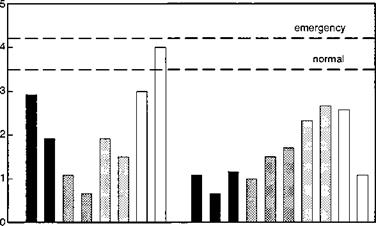Special Flying Qualities
7.3.1 Agility
Agility as a military attribute
In Chapter 6 and Section 7.2, the measurement of flying qualities from objective and subjective standpoints was discussed. Two additional issues arise out of the quality scale and assessment. First, the boundaries are defined for minimum requirements that reflect and exercise moderate levels of the dynamic OFE only, rather than high or extreme levels. Second, the assessments are usually made in ‘clean’ or clinical conditions, uncluttered by secondary tasks, degraded visual cues or the stress of real combat. Beyond the minimum quality levels there remains the question of the value of good flying qualities to the overall mission effectiveness. For example, how much more effective is an aircraft that has, say, double the minimum required (Level 1) roll control
|
|||
|
|


power? A second question asks whether there are any upper limits to the flying qualities parameters, making quality boundaries closed contours. The answers to these questions cannot generally be found in flying qualities requirements like ADS-33. At higher performance levels, very little data are available on flying qualities and, consequently,
there are very few defined upper limits on handling parameters. Regular and safe, or carefree, use of high levels of transient performance has come to be synonymous with agility. The relationship between flying qualities and agility is important because it potentially quantifies the value of flying qualities to operational effectiveness. We will return to this question of value in Section 7.5, but first we examine agility in a more general context.
Operational agility is a key attribute for weapon system effectiveness. Within the broader context of the total weapon system, the mission task naturally extends to include the actions of the different cooperating, and non-cooperating, subsystems, each having its own associated time delay (Ref. 7.19). We can imagine, for example, the sequence of actions for an air-to-air engagement – threat detection, engagement, combat and disengagement; the pilot initiates the action and stays in command throughout, but a key to operational agility is the automation of subsystems – the sensors, mission systems, airframe/engine/control systems and weapon – to maximize the concurrency in the process. Concurrency is one of the keys to operational agility. Another key relates to minimizing the time delays of the subsystems to reach full operational capability and hence effectiveness in the MTE. Extensions to the MTE concept are required which encompass the functions and operations of the subsystems and so provide an approach to assessing system operational agility. Working Group 19, set up by AGARD in 1990, was tasked to address these issues (Ref. 7.19). In this study, addressing both fixed – and rotary-wing aircraft, flying qualities were a major concern. Minimizing time delays is crucial for the airframe, but flying qualities can suffer if the accelerations are too high or time constants too short, leading to jerky motion. The following discussion is based on the author’s contribution to AGARD WG19.
We need to examine how well existing flying qualities requirements address agility, but to set the scene we first reflect on the WG19 generalized definition of agility:
the ability to adapt and respond rapidly and precisely with safety and with poise, to maximise mission effectiveness.
To place this definition in context it is useful to list the four mission phases where agility might be important:
(1) stealthy flying, in particular terrain-masked, to avoid detection;
(2) threat avoidance once detected;
(3) the primary mission (e. g., threat engagement);
(4) recovery and launch from confined, or otherwise demanding, areas.
In addition, we can include the need for agility in response to emergency situations for both military and civil operations, such as those following major system failures. The key attributes of airframe agility, as contained in the above definition, are as follows:
(1) Rapid. Emphasizing speed of response, including both transient and steady-state phases in the manoeuvre change; the pilot is concerned to complete the manoeuvre change in the shortest possible time; what is possible will be bounded by a number of different aspects.
(2) Precise. Accuracy is the driver here, with the motivation that the greater the task precision, e. g., pointing, flight path achievable, the greater the chance of a successful outcome.
(Note: the combination of speed and precision emphasizes the special nature of agility; one would normally conduct a process slowly to achieve precision, but agility requires both.)
(3) Safety. This reflects the need to reduce piloting workload, making flying easy and freeing the pilot from unnecessary concerns relating to safety of flight, e. g., respecting flight envelope limits.
(4) Poise. This relates to the ability of the pilot to establish new steady-state conditions quickly and to be free to attend to the next task; it relates to precision in the last moments of the manoeuvre change but is also a key driver for ride qualities that enhance steadiness in the presence of disturbances.
(Poise can be thought of as an efficiency factor, or measure of the unused energy potential.)
(5) Adapt. The special emphasis here relates to the requirements on the pilot and aircraft systems to be continuously updating awareness of the operational situation; the possibility of rapid changes in the external factors, discussed earlier in this chapter (e. g., threats, UCE, wind shear/vortex wakes), or the internals, through failed or damaged systems, makes it important that agility is considered, not just in relation to set-piece manoeuvres and classical engagements, but also for initial conditions of low energy and/or high vulnerability or uncertainty.
Existing flying qualities requirements address some of these agility attributes implicitly, through the use of the HQRs, which relate the pilot workload to task performance achieved, and explicitly through criteria on response performance, e.g., control power, bandwidth, stability. A new parameter, the agility factor, makes a direct link between inherent vehicle performance and handling.











